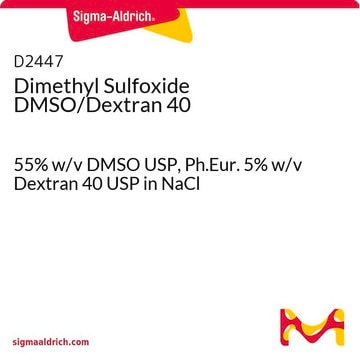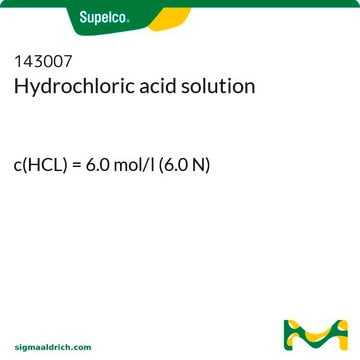H9892
Hydrochloric acid
1.0 N, BioReagent, suitable for cell culture
Synonyme(s) :
Chlorure d’hydrogène solution
About This Item
Produits recommandés
product name
Acide chlorhydrique solution, 1.0 N, BioReagent, suitable for cell culture
Stérilité
sterile-filtered
Niveau de qualité
Gamme de produits
BioReagent
Forme
solution
Concentration
1.0 N
Technique(s)
cell culture | mammalian: suitable
Traces d'anions
chloride (Cl-): passes test
Chaîne SMILES
Cl
InChI
1S/ClH/h1H
Clé InChI
VEXZGXHMUGYJMC-UHFFFAOYSA-N
Vous recherchez des produits similaires ? Visite Guide de comparaison des produits
Description générale
Application
It can also be used:
- In the extraction of elderberry anthocyanins by endothelial cells.
- To convert iron(III) perchlorate to Fe(III) ions which can then form a complex with acetohydroxamic acid (FeAHA).
- to acidify the surface water sample and to prevent interference from carbonate concentrations up to 10 mg L-1 with organic carbon detector (OCD) detection
- to adjust the pH of complete transfection media for transfection with chitosan/pDNA nanoparticle complexes
- to prepare artificial tear solution (ATS) to incorporate the fluorescently tagged cholesteryl ester
Actions biochimiques/physiologiques
Mention d'avertissement
Warning
Mentions de danger
Conseils de prudence
Classification des risques
Met. Corr. 1
Code de la classe de stockage
8B - Non-combustible corrosive hazardous materials
Classe de danger pour l'eau (WGK)
WGK 1
Point d'éclair (°F)
Not applicable
Point d'éclair (°C)
Not applicable
Certificats d'analyse (COA)
Recherchez un Certificats d'analyse (COA) en saisissant le numéro de lot du produit. Les numéros de lot figurent sur l'étiquette du produit après les mots "Lot" ou "Batch".
Déjà en possession de ce produit ?
Retrouvez la documentation relative aux produits que vous avez récemment achetés dans la Bibliothèque de documents.
Les clients ont également consulté
Notre équipe de scientifiques dispose d'une expérience dans tous les secteurs de la recherche, notamment en sciences de la vie, science des matériaux, synthèse chimique, chromatographie, analyse et dans de nombreux autres domaines..
Contacter notre Service technique




